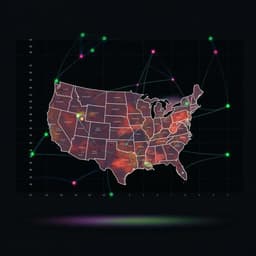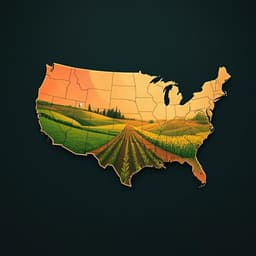
Environmental Studies and Forestry
How will future climate change impact prescribed fire across the contiguous United States?
A. Jonko, J. Oliveto, et al.
Discover how future climate change impacts prescribed fire opportunities across the United States. This research by Alex Jonko, Julia Oliveto, and their esteemed team shows a dramatic shift in suitable burning days, especially concerning rising temperatures and changing weather patterns. An eye-opening study you won't want to miss!
~3 min • Beginner • English
Introduction
The study investigates how future climate change will alter meteorologically suitable windows for applying prescribed fire across the contiguous United States. Prescribed fire is a key tool for reducing hazardous fuels, mitigating catastrophic wildfire risk, and supporting ecosystem function, yet its application depends on specific combinations of temperature, humidity, and wind. A legacy of fire suppression, changing climate, fuel accumulation, and increasing ignitions have heightened wildfire severity, while operational, topographic, and regulatory constraints limit prescribed burning—especially in the western U.S. As temperatures and precipitation variability increase, fuel drying and changing burn windows are expected. The research aims to quantify present (2006–2015) and mid-century (2051–2060) opportunities for prescribed burning by integrating spatially heterogeneous, locally developed prescription windows with downscaled climate projections, thereby informing how and where climate change may constrain or expand prescribed fire opportunities.
Literature Review
Prior research has emphasized wildfire trends and impacts, with comparatively less focus on prescribed fire, which is intentionally ignited under specific prescriptions. Studies show increasing temperatures and drought intensify wildfire risk and may narrow burn windows, with regional analyses demonstrating declines in suitable conditions, e.g., related to relative humidity in California and broader constraints in the southeastern and western U.S. However, many previous assessments applied uniform prescription ranges over broad areas, potentially obscuring local management practices and ecological variability. This study addresses that gap by using locally to regionally specific prescription windows, integrated with fine-scale fuels and climate data, to evaluate geographically heterogeneous changes in prescribed burning opportunities under climate change.
Methodology
Data sources and spatial framework: The analysis used prescribed fire plans from 83 locations across the CONUS obtained from multiple agencies (US National and State Park Services, US Forest Service, US Fish & Wildlife Service, US Air Force, Coalition of Prescribed Fire Councils). For meteorology, present-day (2006–2015) daily data came from gridMET (4 km), and future climate projections from 18 MACA-downscaled CMIP5 models under RCP4.5 and RCP8.5 (also at 4 km). Fuels data relied on LANDFIRE Scott & Burgan surface fuel models (30 m, aggregated to 4 km by modal class). The analysis domain was organized by EPA Level II ecoregions; 16 of 21 Level II ecoregions contained at least one prescription, allowing coverage of 57% of vegetated CONUS.
Prescription variables and harmonization: Prescriptions included minimum and maximum temperature (Tmin, Tmax), minimum and maximum wind speed (WSmin, WSmax), and minimum relative humidity (RHmin). Maximum relative humidity was excluded due to nighttime bias in climate datasets relative to daytime operational thresholds. Where documents provided required and desired ranges, required ranges were used. For documents with ranges for low vs. high fire intensity, the low end of the low-intensity and high end of the high-intensity ranges were used. Fuel types listed as Anderson models were converted to Scott & Burgan equivalents (per a predefined mapping) to align with LANDFIRE fuels.
Assigning prescriptions spatially: Each prescription was associated with an EPA Level II ecoregion. For each 4 km grid cell, the LANDFIRE modal fuel model was compared to fuel types specified in prescriptions for that ecoregion. If matched, the nearest prescription location (by Haversine distance) among those listing that fuel type was selected and applied to the cell.
Burn day computation: For each grid cell and day, a burn day was counted if Tmin, Tmax, RHmin, and daily average WS all fell within the corresponding prescription ranges. This was done for 2006–2015 and 2051–2060 for RCP4.5 and RCP8.5, then averaged to annual burn days. To assess the role of individual constraints, the calculation was repeated using only one meteorological variable at a time (others assumed in prescription), with 365 burn days representing no constraint.
Statistical analysis: Differences in mean annual burn days between periods (2006–2015 vs. 2051–2060) and between scenarios (RCP4.5 vs. RCP8.5 for 2051–2060) were evaluated using a small-sample t-test at 95% confidence. Multiple testing across grid cells was addressed by controlling the false discovery rate (FDR); only differences passing FDR were considered statistically significant.
Seasonality analysis: Monthly climatologies (2006–2015 vs. 2051–2060) for Tmin, Tmax, RHmin, and WS were examined at representative sites spanning key ecoregions to illustrate seasonal shifts in constraints and monthly changes in burn days.
Key Findings
Present-day opportunities: gridMET and CMIP5 show highest current burn days in Warm Deserts (10.2), Ozark/Ouachita–Appalachian Forests (8.4), and Southeastern U.S. Plains (8.3), with >100 burn days also in parts of Mixed Wood Plains (8.1) and Mediterranean California (11.1). Downscaled CMIP5 generally overestimates burn days relative to gridMET over much of CONUS, with largest overestimates (>95 days yr−1) in northern Mixed Wood Plains (8.1), Atlantic Highlands (5.3), Mississippi Alluvial and Southern USA Coastal Plains (8.5), West-Central Semi-Arid Prairies (9.3), and western Western Cordillera (6.2), likely due to wind speed underestimation and RHmin overestimation in CMIP5.
Mid-century changes: Under RCP4.5, burn days decrease across much of the southeastern and eastern U.S., and parts of Warm Deserts (10.2), western Mixed Wood Plains (8.1), and westernmost Western Cordillera (6.2). Increases occur mainly in the western U.S., including Mediterranean California (11.1), Cold Deserts (10.1), Western Cordillera (6.2), and West-Central Semiarid Prairies (9.3). Under RCP8.5, the spatial pattern is similar but magnitudes are larger, with broader statistical significance; decreases in the Southeast nearly double relative to RCP4.5, and increases strengthen in Mediterranean California (significant) and 9.3 (not always significant).
Driver-specific effects: Wind speed is the strongest constraint on burn days. Projected WS decreases increase burn days by ~5–10 days across most areas under RCP4.5, reaching up to ~20 days in parts of 8.3 and 8.4; under RCP8.5, increases are larger in 9.3, but WS increases in portions of 8.3 and 8.4 reduce burn days by ~5 days. Temperature increases are ubiquitous (up to ~3 °C for both Tmin and Tmax by mid-century). Rising Tmin moves days into prescription, especially in northern and western regions: increases of ~20–25 days (RCP4.5) and >30 days (RCP8.5). Rising Tmax pushes days out of prescription almost everywhere: decreases of ~10–30 days (RCP4.5), and >30 days nearly everywhere under RCP8.5 (except southern Mediterranean California). Minimum relative humidity is generally the weakest constraint, with modest declines in RHmin (up to ~3%) translating to small burn day reductions (<10 days under RCP4.5; up to ~20 days in parts of 9.3 under RCP8.5).
Seasonality: Across sites, warming increases burn days during winter and shoulder seasons (via Tmin increases) and decreases summer burn days (via Tmax exceedances). WS trends are site-dependent; decreases can enhance winter/shoulder opportunities, whereas localized increases may reduce summer opportunities.
Discussion
The analysis shows that climate change will differentially affect prescribed fire opportunities across the CONUS. In the eastern and southeastern U.S., more frequent exceedances of Tmax thresholds reduce suitable burn days, exacerbating existing challenges tied to fuel moisture and air quality constraints. In contrast, in many western and northern regions, increased Tmin and generally declining winds expand opportunities, particularly during winter and shoulder seasons, potentially allowing greater application of prescribed fire for fuel reduction and ecosystem management. While RHmin plays a minor limiting role overall, regional impacts emerge in the central prairies and parts of the Rockies. These findings align with the research question by quantifying where and when meteorological windows for safe and effective prescribed burning are likely to shrink or expand under mid-century climate change, offering actionable spatial guidance to managers. However, uncertainties—especially in wind projections and the omission of smoke transport and fuel moisture constraints—suggest that absolute estimates of burn days are likely optimistic; the results are best interpreted as relative, spatially resolved trends in opportunity.
Conclusion
By integrating locally variable prescription windows with downscaled climate projections and fuels data, this study provides a continental-scale assessment of how mid-century climate change will alter opportunities for prescribed fire. It identifies substantial declines in suitable burn days across the Southeast and much of the East due to rising maximum temperatures, alongside increased opportunities in parts of the West and North driven by higher minimum temperatures and reduced winds, with strong seasonal signatures (winter/shoulder increases, summer decreases). This spatially heterogeneous approach advances prior work that used uniform prescriptions, offering more management-relevant insights. Future research should incorporate additional operational constraints (e.g., smoke transport, wind direction, atmospheric stability), explicit fuel moisture and dynamic vegetation/fuel change, sub-daily meteorology, improved wind downscaling, and broader socio-operational factors (air quality regulations, crew availability) to refine opportunity estimates and better support planning and policy.
Limitations
Key limitations include: (1) omission of wind direction and atmospheric stability/smoke transport, which can preclude burning despite favorable basic meteorology; (2) lack of explicit fuel moisture modeling and the assumption of static vegetation/fuel types, despite expected climate-driven changes; (3) use of daily metrics (including exclusion of RHmax due to nighttime bias) that may not fully capture intra-day operational windows; (4) substantial uncertainties in climate-model wind projections and potential biases from downscaling methods; (5) gridMET and CMIP5 likely overestimate burn days because smoke and fuel constraints were not applied; (6) limited spatial coverage—prescription data applied to 57% of vegetated CONUS—leading to gaps in regions without prescriptions; and (7) non-meteorological constraints (air quality regulations, staffing, topography, access) not represented, which can further limit real-world opportunities.
Related Publications
Explore these studies to deepen your understanding of the subject.







